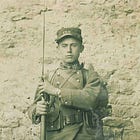In sharp contrast to the British Expeditionary Force of 1914, which a previous article in this series described as “mature,” the French Army of the same year was growing rapidly. The best-known contributor to this expansion was the Three Year Law (Loi des Trois Ans), a statute, adopted in 1913, that added an extra year to the twenty-four month term of service “with the colors” that each qualified young Frenchman was obliged to perform. Less famous than the three-year law, another engine of this great expansion was a law, approved in 1912, that extended conscription to the Muslim population of Algeria. (Before 1912, only members of the European and Sephardic communities had been subject to mandatory military service, which they often performed in zouave battalions.)
Implemented immediately, the Three Year Law increased the number of conscripts in uniform by fifty percent. In theory, this great change did nothing to increase the size of the mobilized military forces of France. In practice, however, it encouraged many young Frenchmen to take the trouble to seek promotion to the rank of sergeant. (One way to do this was to take courses offered, on evenings and weekends, by local pre-military training clubs. Another involved contracting an enlistment prior to the call-up of one’s year group.)
The growth in the number of sergeants had two effects. For one thing, it facilitated the formation of a small number of new units, such as batteries of mobile heavy artillery, companies of chasseurs, and battalions of zouaves. The second effect added to the number of men willing to apply for commissions, whether as reserve officers or second lieutenants of the active army. In other words, the prospect of spending three years in uniform, rather than two, convinced many young men, who might previously have viewed military service as a chore to be completed with the bare minimum of effort, to embrace the experience.
The extension of conscription to the Muslim population of Algeria had the obvious effect of increasing the number of “native” units in the Army of Africa (Armée d’Afrique), most of which were battalions of Algerian Sharpshooters (tirailleurs algériens). At the same time, the longstanding policy of ensuring that there was at least one battalion of zouaves for every three battalions of tirailleurs led to the creation of new units of the former type.
The European and Sephardic communities of Algeria produced too few young men to fill the ranks of additional zouave battalions. Thus, the French War Ministry stationed the new “African” units in Paris and Lyons, thereby facilitating the conscription of young men living in those cities. The placement of zouave units in large cities in the French heartland also made it easier to employ tirailleur battalions in a war against Germany.
For Further Reading:
To Support, Share, and Subscribe:








